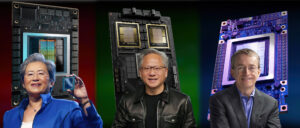Introduction:
In the realm of large language models (LLMs), Meta Llama 3 stands as a testament to the evolution of AI-driven capabilities. NVIDIA, a pioneer in accelerated computing, has joined forces with Meta to optimize Llama 3 across diverse platforms.
NVIDIA makes graphics processing units (GPUs) known for their speed and power. In this case, NVIDIA has made adjustments to its hardware and software (across all their platforms like cloud, data centers, personal computers etc.) specifically to make Meta Llama 3 run faster and more efficiently.
This means that thanks to NVIDIA’s work, Meta Llama 3 should be able to process information and respond to requests much quicker. This could lead to a smoother user experience for various applications that use LLMs.
This collaboration opens doors for developers, researchers, and businesses to harness the power of generative AI responsibly and innovatively.
In this blog post, we delve into the intricacies of NVIDIA’s optimizations and how they propel the deployment of Llama 3 across cloud, data center, edge, and PC environments.
Follow us on Linkedin for everything around Semiconductors & AI
Training Infrastructure:
Meta Llama 3 is a large language model (LLM) created by Meta. LLMs are essentially AI systems trained on massive amounts of text data to perform tasks like writing different kinds of creative content, translating languages, and answering your questions in an informative way. Think of it as a super-powered chatbot that’s really good at understanding and using language.
Behind the prowess of Llama 3 lies a robust training infrastructure powered by NVIDIA’s cutting-edge technologies.
Meta engineers undertook the monumental task of training Llama 3 on computer clusters boasting 24,576 NVIDIA H100 Tensor Core GPUs.
This formidable setup, coupled with RoCE and NVIDIA Quantum-2 InfiniBand networks, such as laid the groundwork for pushing the boundaries of generative AI.
Moreover, Meta’s ambitious plans to scale infrastructure to 350,000 H100 GPUs signify a commitment to advancing the state of the art in AI.
Read More:AI GPU Market 2024: NVIDIA dominates with $40B, AMD rises to $3.5B, Intel lags at $500M – techovedas
Deployment Across Platforms:
NVIDIA’s optimizations pave the way for seamless deployment of Llama 3 across various platforms, catering to a spectrum of use cases.
Moreover,Developers can now access accelerated versions of Llama 3 via the cloud, data center, edge, and PC environments.
Through NVIDIA’s NIM microservice and standard API, deploying Llama 3 becomes a streamlined process, empowering developers to leverage its capabilities anywhere.
Additionally, businesses can fine-tune Llama 3 using NVIDIA NeMo, optimizing models for inference with TensorRT-LLM and deploying them with Triton Inference Server, thus ensuring efficient utilization of resources.
Read More: 8 Companies Poised to Benefit Significantly from the AI Boom – techovedas
Inference Performance:
Optimizing inference performance is paramount for unleashing the full potential of Llama 3. NVIDIA’s GPUs, including the H200 Tensor Core GPU and Jetson Orin for edge computing, play a pivotal role in achieving optimal performance metrics.
In initial tests, a single H200 GPU demonstrated the capability to generate 3,000 tokens per second, translating to efficient service for hundreds of users simultaneously.
Furthermore, edge devices powered by Jetson AGX Orin and Jetson Orin Nano exhibited impressive token generation rates, further enhancing the accessibility of Llama 3 across diverse computing environments.
Read More: Level Up Your Electronics: 7 Types of Arduino Boards to Make Your Own Gadget – techovedas
Advancing Competition with ChatGPT:
NVIDIA’s optimization for Meta Llama 3 could have several implications for ChatGPT, its competitor in the large language model (LLM) space:
Increased Competition: This is a shot across the bow for OpenAI’s ChatGPT. A faster and potentially more powerful Meta Llama 3 could attract users and developers who prioritize speed and efficiency. This could lead to a more competitive landscape, pushing both companies to innovate further.
Pressure to Improve: ChatGPT may feel pressure to improve its own performance and efficiency. OpenAI, the developers behind ChatGPT, might look into optimizing their model for specific hardware or explore partnerships with hardware manufacturers like NVIDIA.
Focus on Differentiation: Both ChatGPT and Meta Llama 3 might need to emphasize their unique strengths beyond just speed. This could involve focusing on specific functionalities, user interfaces, or areas of expertise where each LLM excels.
Uncertain Impact on Users: The impact on everyday users might not be immediate. While a faster Llama 3 could lead to smoother interactions, it depends on how the technology is implemented by different applications. However, in the long run, this competition could benefit users by driving innovation and potentially lead to more powerful and versatile LLMs.
Overall, NVIDIA’s move is a positive development for the LLM space, pushing the boundaries of what these models can achieve. It’s too early to say definitively how this will affect ChatGPT, but it will likely lead to a more competitive and dynamic landscape.
Read More: 8 Netflix Movies Redefining Artificial Intelligence – techovedas
Conclusion:
In conclusion, NVIDIA’s optimizations mark a significant milestone in the journey of accelerating Meta Llama 3.
By harnessing the power of NVIDIA’s accelerated computing technologies, developers, researchers, and businesses can leverage Llama 3’s capabilities across a myriad of platforms.
From cloud-based deployments to edge computing devices, Llama 3 emerges as a versatile tool for driving innovation responsibly.
As NVIDIA continues to push the boundaries of AI inference, the future holds boundless possibilities for advancing generative AI and empowering the global AI community.



